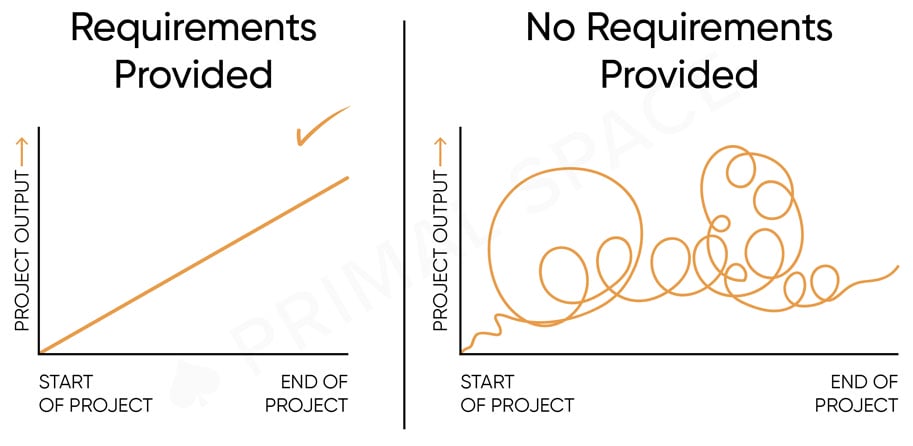
How to Create Requirements Documents
Outlining your requirements is one of the most important parts of any project. In this post we show you how to create digital requirements documents that set your next project up for success.
Technical requirements are a key step of the design and development process. Mapping the direction of the rest of the assignment. The more specific and detailed your requirements are the better. Clearly defined requirements mean your supplier can navigate the task of producing an outcome that adds value to your business. Having the full picture and proposed requirements in place before starting aids greatly with this. While also keeping the project within the defined budget and to the timescale that you require. All that without missing any of the functionality or key elements included within the project requirements document. This doc is often referred to as a Business Requirement Document (BRD). Or Business Requirement Specification Document (BRSD). Ultimately used to describe and define the required solutions for a project.
It has become really clear to our team at Primal Space, that we need to help our clients with defining requirements more clearly from the outset. So we’ve decided to write this new blog post to help! Expanding on a few previous posts in our blog area, which cover this topic already. But now going into a little more depth on the subject. With an added example of our own digital project requirements template that we are very happy to share with you. While also referring to some third party articles providing further reading on the subject for more in-depth learning on the process of documenting requirements for your business.
Why we ask for Requirements Documentation
Vague requirements that aren’t clearly defined, result in a blurry vision of what is essential for the project at hand. We can’t create a piece of work you’ll love unless we know what you want to achieve. As your supplier, we won’t know what you want to accomplish through the project, unless you have taken the time to consider this yourself. It’s an important step that should never be overlooked as it’s where ideas and planning evolve into concrete tangible ideas. From here we can establish your main objectives and translate these into something functional that provides a valuable asset for your business.
Without clear requirements it’s easy for our visions to get tangled and move in opposite directions. Therefore unless detailed requirements are outlined, we’ll waste a lot of time creating what we think you want. Yet still not quite hitting the objective, because it wasn’t clear from the outset. This is a costly process for you, the client and can lead to a lot of frustration at both ends. As neither party is able to find a way to fulfil an unclear vision.
How to Gather Your Requirements
Getting clear on your vision for the project is the most important step you’ll take. Set time aside to do this. It can be as simple as sitting down with a blank sheet of paper and brainstorming all of the ideas and problems you’re trying to solve by creating this piece of work.
It starts by getting clear on your why. Some questions to ask yourself include;
- Why are you undertaking this project?
- What are you trying to achieve?
- Who will this positively impact?
- What value are you hoping to create?
Timescale and Budget
Next, it’s important to consider the timescale and budget constraints your working within. This is important for us to know from the outset, but also for you to be clear on. If we know you have a budget in mind we may be able to offer alternative solutions to reach the same objective, but reduce your overall costs.
One thing we specialise in here at Primal Space, is offering an exceptionally high return on investment for our clients. To achieve this, we need to know the parameters to work within. Which aids in identifying the methods to achieve the best results for your budget. To date, we have worked on projects with budgets as little as £500, or as much as £50,000, and everything in between. Within reason, your project budget shouldn’t limit your ability to achieve fantastic results. But poor planning, and a lack of defined requirements definitely can create limitations.
Likewise, a short timescale on your requirements can limit the results we achieve together. So try to plan ahead and, where possible, give advanced notice of upcoming requirements. As we generally book in projects months in advance. Regardless of timescale, it’s essential you think your requirements out from start to finish. Creating a clear document for us to follow, so we understand the full picture. This saves any potential banana skins at the end of a piece of work. That can increase the overall scope of work, and ultimately the timescale and project cost increase along with it too. So take your time, get the planning done in depth correctly and clearly defined in a single document for optimum results.
Technical Requirements
We’ll also need to know about any technical requirements of the project. Are there specific design elements that must be included? What are other non-negotiables? Do you have digital examples of what you’re trying to accomplish? Perhaps it’s a slick registration process. Or maybe you’ve found a great way to showcase your products on a third party website that you know your customers would engage with. Perhaps there’s a great video feature that you’d like to incorporate or a slider that makes your web pages more interactive.
By showing us examples of the feature your considering as part of the project brief and telling us why your considering this we’ll be able to work with you to create the best possible outcome. In some cases we’ll be able to come up with a solution that’s even better. Because we know we’re moving with you in the same direction towards the same end goal.
What to Include in your Requirements Document
A good business requirements document will include the features you require. As well as a definition of these features for clearer understanding and examples (often visual) of these features. We’ve created an example of what to include and how you can provide your project requirements to us on the link below. This is a good example which includes some of the points we’ve had you consider earlier in this post. However depending on the project, there may well be other things you’d like to include.
Primal Space Requirements Document Template
The below document is a blank example of a basic Google Docs requirements template we have provided to our clients to use:
Primal Space Requirements Blank Document Template
You’re welcome to use this as a guide to create your own requirements document (of course adding in the content and requirements that are specific to your digital project). This example is a very simple document that lets you get started. However, larger projects may require additional sections added to include a glossary, project timeline requirements and milestones. As well as an introduction explaining document purpose, stakeholders for the project, vision and business objectives. You may also wish to include the purpose of the features required, document version history. In addition to this any dependencies we should be made aware of.
You can ultimately include whatever you like within your document. But as as general rule, the more information that is included, the better.
Examples of Requirements Documents
Below we have listed some external articles that consist of some examples of requirements documents and templates for further inspiration:
- Requirements Document Examples to Inspire You
- Business Requirements Document Examples
- Simple Business Requirements Document Templates
- Business Requirements Document Templates for Word
- Project Requirements Template Doc for Excel
These articles have not been contributed to by us, here at Primal Space, and are just to be used for ideas. Helping you create your own business/project requirements document to issue to us.
Providing us with your Digital Requirements
Once you have completed your requirements documents and have checked through thoroughly that everything is included. It’s important that you submit these to us directly via email. We’ll also ask that you upload copies to our shared Google Drive area that you’ll have been provided with. Allowing us both to access the document and provide updates and progress on the project from there.
Our preference at the moment is for requirements to be created in Google Drive using a Google Sheet or Google Doc. Which allows multiple editors to be working collaboratively at the same time. As well as recognised version control. Among other benefits such as the ability to add comments and document update tracking.
Upon receiving your requirements, and once we’ve had time to properly review these, we’ll arrange a discovery video call with you during the research and planning phase of your web project. Allowing us to discuss everything before we commence with work. Giving us the opportunity to clarify any questions that may arise before moving forward with any design or development tasks.
The Importance of Gathering Requirements
We really hope this post has added some value and helped you understand how to create requirements documents for your business. You’ll now have a clearer understanding of the importance of detailed and constructive project requirements. Aiding us to understand your objectives and bring your vision to life. While creating work for you that delivers efficiently from a budget and timescale perspective. By taking the time to create your project goals and vision, we’ll both be in a better position to carry out the task at hand.
Submitting a requirements document before we undertake any new project, or new tasks on an existing project, is a requirement of ours ongoing. For all new and existing clients. If you are interested in our digital services then please reach out to us with your website requirements.
You can find out more about client requirements in a previous blog post which may spark some additional ideas on what to provide us with for your project, no matter how large or small.





